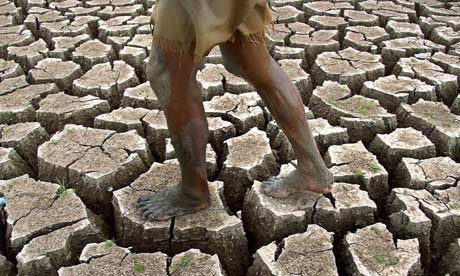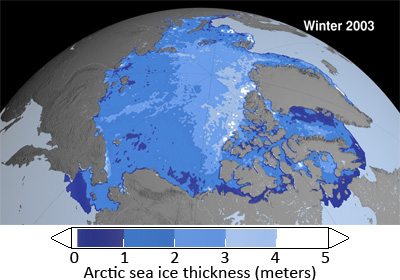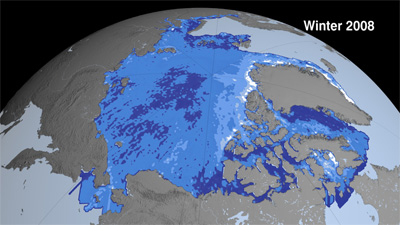Impacts of climate change coming faster and sooner: New science report underlines urgency for governments to seal the deal in Copenhagen
Washington/Nairobi, 24 September 2009 -The pace and scale of climate change may now be outstripping even the most sobering predictions of the last report of the Intergovernmental Panel of Climate Change (IPCC).
An analysis of the very latest, peer-reviewed science indicates that many predictions at the upper end of the IPCC's forecasts are becoming ever more likely.
Meanwhile, the newly emerging science points to some events thought likely to occur in longer-term time horizons, as already happening or set to happen far sooner than had previously been thought.
Researchers have become increasingly concerned about ocean acidification linked with the absorption of carbon dioxide in seawater and the impact on shellfish and coral reefs.
Water that can corrode a shell-making substance called aragonite is already welling up along the California coast decades earlier than existing models predict.
Losses from glaciers, ice-sheets and the Polar Regions appear to be happening faster than anticipated, with the Greenland ice sheet, for example, recently seeing melting some 60% higher than the previous record of 1998.
Some scientists are now warning that sea levels could rise by up to two metres by 2100 and five to ten times that over following centuries.
There is also growing concern among some scientists that thresholds or tipping points may now be reached in a matter of years or a few decades including dramatic changes to the Indian sub-continent's monsoon, the Sahara and West Africa monsoons, and climate systems affecting a critical ecosystem like the Amazon rainforest.
The report also underlines concern by scientists that the planet is now committed to some damaging and irreversible impacts as a result of the greenhouse gases already in the atmosphere.
Losses of tropical and temperate mountain glaciers affecting perhaps 20-25% of the human population in terms of drinking water, irrigation and hydro-power.
Shifts in the hydrological cycle resulting in the disappearance of regional climates with related losses of ecosystems, species and the spread of drylands northwards and southwards away from the equator.
Recent science suggests that it may still be possible to avoid the most catastrophic impacts of climate change. However, this will only happen if there is immediate, cohesive and decisive action to both cut emissions and assist vulnerable countries adapt.
These are among the findings of a report released today by the United Nations Environment Programme (UNEP) entitled Climate Change Science Compendium 2009.
The report, compiled in association with scientists around the world, comes with less than 80 days to go to the crucial UN climate convention meeting in Copenhagen, Denmark.
In a foreword to the document, the United Nations Secretary-General, Ban Ki-moon, who this week hosted heads of state in New York, writes, "This Climate Change Science Compendium is a wake-up call. The time for hesitation is over."
"We need the world to realize, once and for all, that the time to act is now and we must work together to address this monumental challenge. This is the moral challenge of our generation."
The Compendium reviews some 400 major scientific contributions to our understanding of Earth Systems and climate change that have been released through peer-reviewed literature, or from research institutions, over the last three years.
Achim Steiner, UN Under-Secretary General and UNEP Executive Director, said, "The Compendium can never replace the painstaking rigour of an IPCC process -- a shining example of how the United Nations can provide a path to consensus among the sometimes differing views of more than 190 nations."
"However, scientific knowledge on climate change and forecasting of the likely impacts has been advancing rapidly since the landmark 2007 IPCC report," he added.
"Many governments have asked to be kept abreast of the latest findings. I am sure that this report fulfils that request and will inform ministers' decisions when they meet in the Danish capital in only a few weeks time," said Mr. Steiner.
The research findings and observations in the Compendium are divided into five categories: Earth Systems, Ice, Oceans, Ecosystems and Management. Key developments documented since the IPCC Fourth Assessment Report include:
Earth Systems
A new climate modeling system, forecasting average temperatures over a decade by combining natural variation with the impacts of human-induced climate change, projects that at least half of the 10 years following 2009 will exceed the warmest year currently on record. This is despite the fact that natural variation will partially offset the warming "signal" from greenhouse gas emissions.
The growth in carbon dioxide emissions from energy and industry has exceeded even the most fossil-fuel intensive scenario developed by the IPCC at the end of the 1990s. Global emissions were growing by 1.1% each year from 1990-1999 and this accelerated to 3.5% per year from 2000-2007.
The developing and least-developed economies, 80% of the world's population, accounted for 73%of the global growth of emissions in 2004. However, they contributed only 41% of total emissions, and just 23% of cumulative emissions since 1750.
Growth of the global economy in the early 2000s and an increase in its carbon intensity (emissions per unit of growth), combined with a decrease in the capacity of ecosystems on land and the oceans to act as carbon "sinks," have led to a rapid increase in the concentrations of carbon dioxide in the atmosphere. This has contributed to sooner-than-expected impacts including faster sea-level rise, ocean acidification, melting Arctic sea ice, warming of polar land masses, freshening of ocean currents and shifts in the circulation patterns of the oceans and atmosphere.
The observed increase in greenhouse gas concentrations are raising concern among some scientists that warming of between 1.4 and 4.3 °C above pre-industrial surface temperatures could occur. This exceeds the range of between 1 and 3 degrees perceived as the threshold for many "tipping points," including the end of summer Arctic sea ice, and the eventual melting of Himalayan glaciers and the Greenland ice sheet.
Ice
The melting of mountain glaciers appears to be accelerating, threatening the livelihoods of one fifth or more of the population who depend on glacier ice and seasonal snow for their water supply. For 30 reference glaciers in nine mountain ranges tracked by the World Glacier Monitoring Service, the mean rate of loss since 2000 has roughly doubled since the rate during the previous two decades. Current trends suggest that most glaciers will disappear from the Pyrenees by 2050 and from the mountains of tropical Africa by 2030.
In 2007, summer sea ice in the Arctic Ocean shrank to its smallest extent ever, 24% less than the previous record in 2005, and 34% less than the average minimum extent in the period 1970-2000. In 2008, the minimum ice extent was 9% greater than in 2007, but still the second lowest on record.
Until the summer of 2007, most models projected an ice-free September for the Arctic Ocean towards the end of the current century. Reconsideration based on current trends has led to speculation that this could occur as soon as 2030.
Melting of the Greenland Ice Sheet surface also seems to be accelerating. In the summer of 2007, the rate of melting was some 60% higher than the previous record in 1998.
The loss of ice from West Antarctica is estimated to have increased by 60% in the decade to 2006, and by 140% from the Antarctic Peninsula in the same period.
Recent findings show that warming extends well to the south of the Antarctic Peninsula, to cover most of West Antarctica, an area of warming much larger than previously reported.
The hole in the ozone layer has had a cooling effect on Antarctica, and is partly responsible for masking expected warming on the continent. Recovery of stratospheric ozone, thanks to the phasing out of ozone-depleting substances, is projected to increase Antarctic temperatures in coming decades.
Oceans
Recent estimates of the combined impact of melting land-ice and thermal expansion of the oceans suggest a plausible average sea level rise of between 0.8 and 2.0 metres above the 1990 level by 2100. This compares with a projected rise of between 18 and 59 centimetres in the last IPCC report, which did not include an estimate of large-scale changes in ice-melt rates, due to lack of consensus.
Oceans are becoming more acidic more quickly than expected, jeopardizing the ability of shellfish and corals to form their external skeletons. Water that can corrode a shell-making carbonate substance called aragonite is already welling up during the summer along the California coast, decades earlier than models predict.
Ecosystems
Since the 2007 IPCC report, wide-ranging surveys have shown changes to the seasonal behaviour and distribution of all well-studied marine, freshwater and terrestrial groups of plants and animals. Polar and mountaintop species have seen severe contractions of their ranges.
A recent study projecting the impacts of climate change on the pattern of marine biodiversity suggests dramatic changes to come. Ecosystems in sub-polar waters, the tropics and semi-enclosed seas are predicted to suffer numerous extinctions by 2050, while the Arctic and Southern Oceans will experience severe species invasions. Marine ecosystems as a whole may see a species turnover of up to 60%.
Under the IPCC scenario that most closely matches current trends, i.e., with the highest projected emissions between 12 and 39% of the Earth's land surface could experience previously unknown climate conditions by 2100. A similar proportion, between 10 and 48%, will see existing climates disappear. Many of these "disappearing climates" coincide with biodiversity hotspots, and with the added problem of fragmented habitats and physical obstructions to migration, it is feared many species will struggle to adapt to the new conditions.
Perennial drought conditions have already been observed in South-eastern Australia and South-western North America. Projections suggest that persistent water scarcity will increase in a number of regions in coming years, including southern and northern Africa, the Mediterranean, much of the Middle East, a broad band in Central Asia and the Indian subcontinent.
Management
The reality of a rapidly-changing climate may make conventional approaches to conservation and restoration of habitats ineffective. Drastic measures such as large-scale translocation or assisted colonization of species may need to be considered.
Eco-agriculture, in which landscapes are managed to sustain a range of ecosystem services, including food production, may need to replace the current segregation of land use between conservation and production. This could help create resilient agricultural ecosystems better able to adapt to the changing climate conditions.
Experts increasingly agree that active protection of tropical forests is a cost-effective means of cutting global emissions. An international mechanism of reducing emissions from deforestation and forest degradation (REDD) is likely to emerge as a central component of a new agreement in Copenhagen. However, many issues need to be resolved, such as how to verify the reductions and ensuring fair treatment of local and indigenous forest communities.
A number of innovative approaches are emerging to keep carbon out of the atmosphere, including the use of "biochar," biologically-derived charcoal. It is mixed in soils, increasing fertility and potentially locking up carbon for centuries. This is a 21st century application of a technology known as Terra Preta, or Black Earth, used by Amazon peoples before the arrival of Europeans in South America.
To download the full report, visit http://www.unep.org/compendium2009/
For more information please contact:
Nick Nuttall, UNEP Spokesperson and Head of Media, on Tel: +254 20 7623084, Mobile: +254 733 632755, or when travelling: +41 795965737, or e-mail: nick.nuttall@unep.org;
Elisabeth Guilbaud-Cox, Senior Communications Officer, UNEP Regional Office for North America, Tel: 1 (202) 974-1307, Mobile: 1 (202) 812-2100, e-mail: elisabeth.guilbaud-cox@unep.org



















